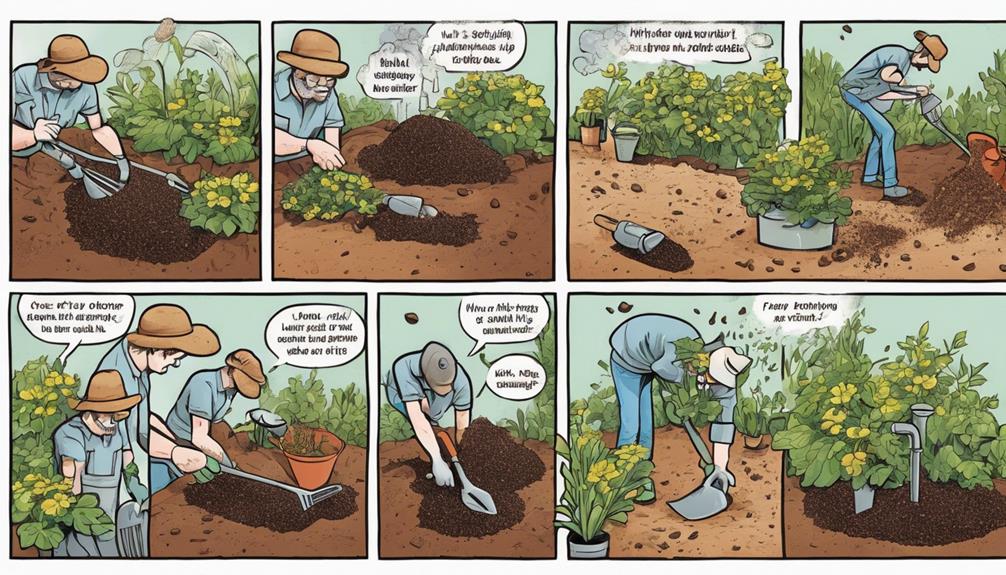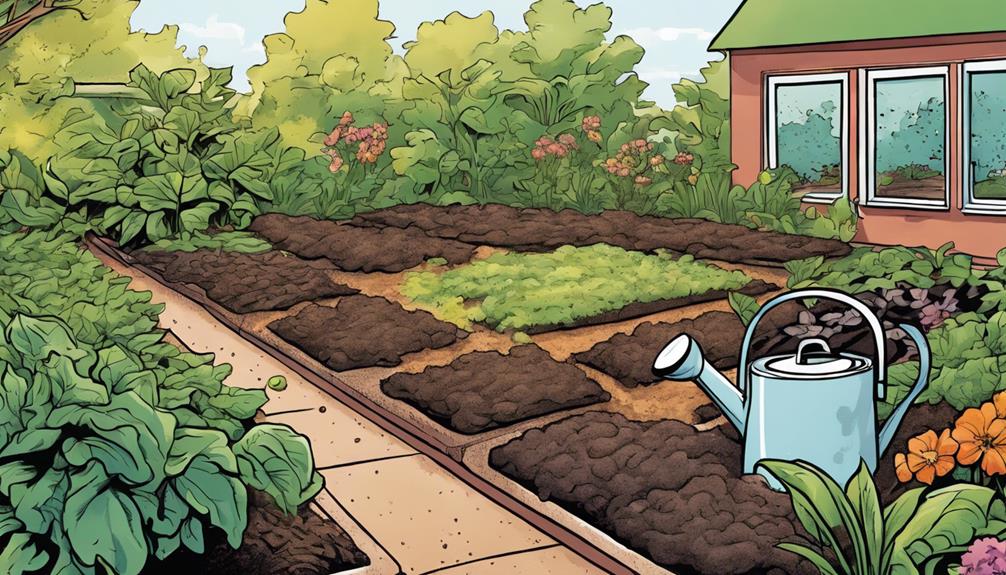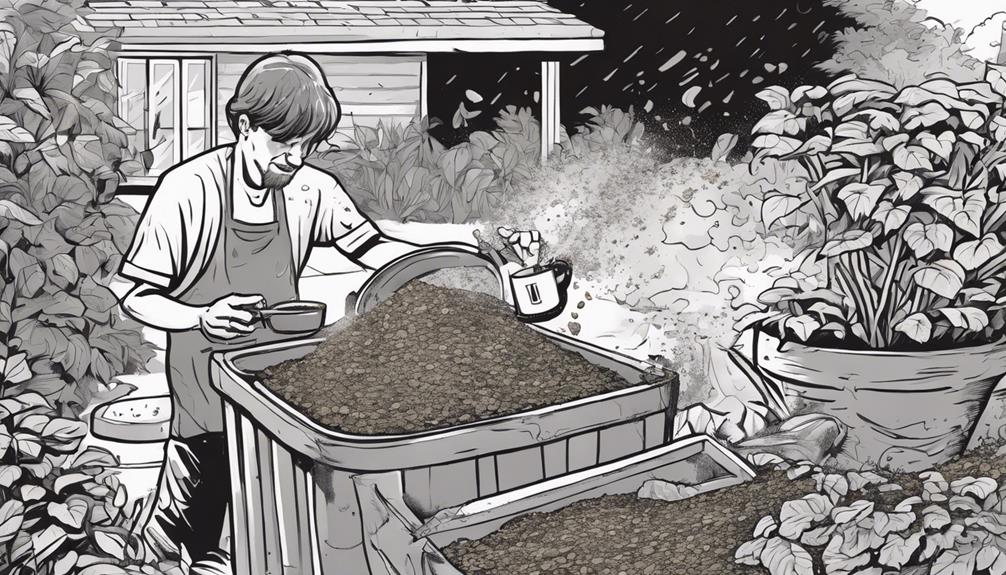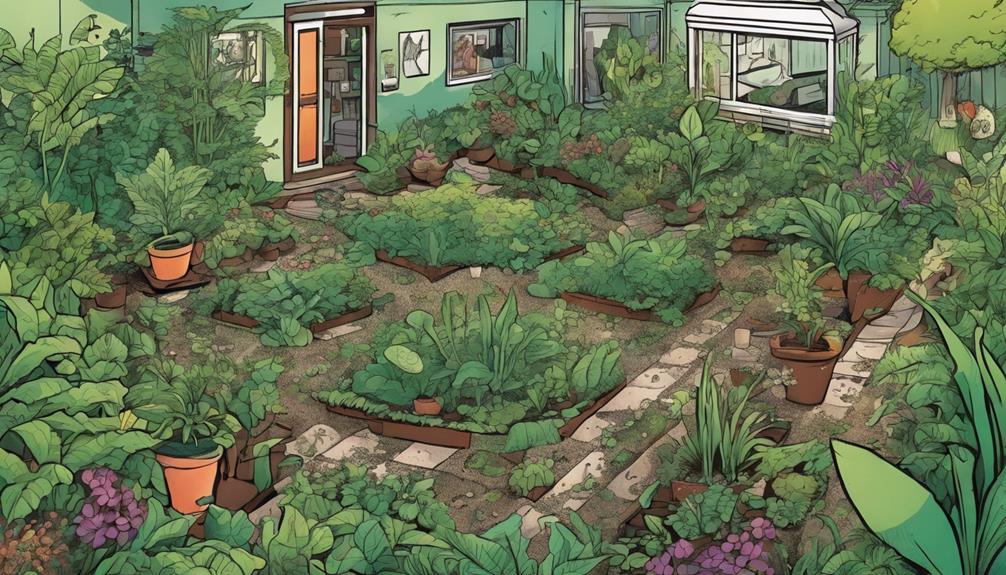Improve your garden’s health with coffee grounds! Sprinkle them around plants for important nutrients like nitrogen, potassium, and phosphorus. Mix them into the soil when planting for better growth and weed control. Remember to monitor pH levels and use them moderately to maintain soil balance. Acid-loving plants such as azaleas and blueberries benefit from the advantages of coffee grounds. Try different application methods to see your garden flourish even more.
Key Takeaways
- Sprinkle coffee grounds around plants for nutrient-rich soil.
- Mix coffee grounds into soil during planting for weed suppression.
- Add coffee grounds to compost to deter pathogens and cats.
- Apply coffee grounds directly to deter weeds and pathogens.
- Work coffee grounds into soil for root crop benefits.
Benefits of Coffee Grounds for Plants
Enhancing plant growth and soil quality, coffee grounds offer numerous benefits for your garden. When incorporated into the soil, coffee grounds provide essential nutrients like nitrogen, potassium, and phosphorus, acting as a natural fertilizer for your plants.
The organic matter in coffee grounds improves soil structure, promoting healthy soil and enhancing plant growth.
Moreover, coffee grounds aid in moisture retention, creating an ideal environment for plant roots to thrive. By holding moisture in the soil, coffee grounds help prevent water loss and maintain consistent hydration levels for your plants.
Additionally, these grounds can act as a pest repellent, deterring common garden pests such as slugs and snails. This natural pest control method contributes to plant health by reducing the risk of damage caused by these intruders.
Incorporating coffee grounds into your garden not only enriches the soil with nutrients but also supports plant growth, moisture retention, and pest management, fostering a vibrant and healthy garden ecosystem.
Considerations When Using Coffee Grounds

Consider carefully these important factors when utilizing coffee grounds in your garden to guarantee peak plant health and soil quality.
- Check the pH preferences of your plants before applying coffee grounds to avoid potential adverse effects.
- Mix coffee grounds with other compost materials to ensure a balanced nutrient profile for your plants.
- Using coffee grounds in moderation is key to prevent acidity buildup in the soil over time.
- Make certain coffee grounds are fully dried before applying them to prevent mold growth in your garden.
Remember that different plants have specific needs, so consider the soil type and the requirements of each plant before incorporating coffee grounds into your gardening routine.
By understanding the acidity levels, nutrient profiles, and proper application methods, you can harness the benefits of coffee grounds effectively without causing harm to your plants or the soil.
Be mindful of these considerations to optimize the advantages of using coffee grounds in your garden. First, it’s important to use coffee grounds in moderation, as excessive amounts can alter the acidity of the soil and disrupt the pH balance. Additionally, it’s best to apply coffee grounds to the surface of the soil rather than mixing them in, to prevent them from compacting and restricting water and air flow. Finally, when applying coffee grounds to azaleas, avoid spreading them too close to the base of the plant, as this can lead to mold or fungal growth. Instead, distribute them evenly around the drip line to provide a slow-release source of nutrients for the plant.
Plants Benefiting From Coffee Grounds

Certain plants in your garden can greatly benefit from the utilization of coffee grounds due to their specific nutrient requirements and soil preferences. Acid-loving plants such as azaleas, blueberries, and rhododendrons thrive with the acidic nature of coffee grounds. These plants require slightly acidic soil conditions, making coffee grounds a perfect addition to enhance their growth.
Additionally, vegetables like tomatoes, peppers, and carrots benefit from the nitrogen-rich content found in used coffee grounds. The slow-release nutrients present in coffee grounds are appreciated by flowers such as hydrangeas and camellias, promoting their overall health and blooming potential.
Plants Avoiding Coffee Grounds

Plants that prefer alkaline soil conditions, such as roses and chrysanthemums, should avoid coffee grounds. These plants thrive in a specific pH range, and the acidity of coffee grounds can disrupt their growth.
Also, succulents and cacti, which are sensitive to excess moisture, aren't suitable candidates for the application of coffee grounds. The moisture-retaining properties of coffee grounds can lead to root rot in these plants.
Additionally, species prone to fungal diseases should steer clear of coffee grounds, as the moist environment created by the grounds can worsen fungal growth.
Lastly, seedlings and young plants with delicate root systems should be kept away from coffee grounds to prevent any potential harm. It's important to take into account the specific needs of each plant, and for those requiring well-draining soil, using coffee grounds may lead to waterlogging issues.
Choose alternative soil amendments for these plants to support their ideal growth.
Tips for Using Coffee Grounds

Use properly dried coffee grounds in your garden to prevent mold growth and enhance plant health. When applying coffee grounds, remember to layer them thinly, no thicker than 1/2 inch, to prevent issues with acidity that might harm your plants.
Repurposing coffee grounds is a great way to benefit your garden; consider composting them to create nutrient-rich soil or using them as mulch to retain moisture and suppress weeds. Another tip is to make a liquid fertilizer by steeping coffee grounds in water to create a potent plant tea full of beneficial nutrients.
Additionally, coffee grounds can serve as a natural pest deterrent in your garden. To keep pests like wasps, slugs, and snails at bay, strategically place coffee grounds in areas where these critters frequent.
Applying Coffee Grounds in Soil

When incorporating coffee grounds into your soil, it's essential to acknowledge their beneficial impact on plant health and soil structure. By adding coffee grounds, you can enrich the soil with vital soil nutrients such as nitrogen, potassium, and phosphorus. This helps improve soil structure by increasing organic matter content, which in turn enhances drainage capabilities.
Additionally, the coffee grounds aid in retaining moisture within the soil, while also acting as a natural pest control method, deterring pests like slugs and snails. To make sure a balanced nutrient content, consider mixing the coffee grounds with compost or mulch before applying them to the soil.
Using Coffee Grounds as Mulch

Consider incorporating coffee grounds as mulch in your garden to benefit your plants and improve soil health. Mulching with coffee grounds is an excellent way to retain moisture in the soil and suppress weed growth effectively. Since coffee grounds decompose slowly, they provide a steady release of nutrients that can enhance the overall health of your plants. This sustainable gardening practice not only helps recycle waste but also enriches the soil in a natural way.
Moreover, using coffee grounds as mulch is particularly advantageous for acid-loving plants like azaleas and blueberries. These plants thrive in acidic soil conditions, making coffee grounds a perfect choice to meet their specific needs. By applying a thin layer of coffee grounds around your plants, you can create a favorable environment for them to grow and flourish.
Embracing mulching with coffee grounds not only benefits your plants but also contributes to sustainable gardening practices by repurposing coffee waste effectively.
Composting Coffee Grounds

Enhance your compost pile with the valuable nutrients found in coffee grounds, such as proteins, fatty acids, and carbohydrates.
When composting coffee grounds, you introduce a rich source of green compost material that benefits the overall health of your compost. Coffee grounds release these nutrients over time, promoting microbial activity and raising the internal temperature of the pile.
To guarantee the compost remains balanced, limit the coffee grounds to 10% of the total volume to avoid issues with acidic soil. Additionally, adding coffee grounds to your compost can help eliminate pathogenic bacteria and weed seeds, enriching the quality of the final compost.
If you encounter acidity problems, consider balancing the coffee grounds with lime or wood ash to maintain a neutral pH level. Composted coffee grounds offer a natural way to improve your compost while providing essential nourishment for your plants.
Coffee Grounds as Fertilizer

Introduce coffee grounds as a beneficial natural fertilizer for your garden, providing essential nutrients like nitrogen, potassium, and phosphorus to support plant growth. When used as fertilizer, coffee grounds enrich the soil with organic matter, promoting healthy plant growth. They're particularly beneficial for plants like tomatoes, cabbage, and fruit trees due to their nutrient content.
Additionally, coffee grounds can be repurposed into a liquid fertilizer by steeping them in water, creating a nutrient-rich solution to feed your plants.
One significant advantage of using coffee grounds as fertilizer is their pH level. Fresh coffee grounds are acidic, but once used, they become neutral. This versatility allows you to cater to the specific needs of different plants in your garden.
Using Fresh Coffee Grounds

You can harness the benefits of fresh coffee grounds to give your acid-loving plants like azaleas and blueberries a natural boost.
Enhance the growth of root crops such as radishes and carrots by mixing fresh coffee grounds with soil during planting.
Discover how fresh coffee grounds can help suppress weeds, deter fungal pathogens, and even act as a natural cat repellent in your garden.
Benefits of Fresh Grounds
When incorporating fresh coffee grounds into your garden, you can benefit acid-loving plants like azaleas and blueberries. These grounds contain nitrogen, making them a great addition to the soil for plants that thrive in acidic environments.
Additionally, you can use fresh coffee grounds to make compost tea, a nutrient-rich liquid fertilizer that can boost the overall health of your garden.
In addition, adding coffee grounds to the soil at planting time can provide support for root crops such as radishes and carrots.
Not only that, but the allelopathic properties of fresh coffee grounds can act as a natural weed suppressant, helping to keep unwanted plants at bay.
Besides, these grounds can also deter certain fungal pathogens, contributing to a healthier garden environment.
Explore using coffee grounds in your garden not only for their benefits to plants but also for their versatility in applications such as vermicomposting and as a cat repellent.
Application Techniques
Consider applying fresh coffee grounds directly around your plants to maximize their benefits in the garden. When using grounds this way, you provide a nutrient-rich environment while deterring weeds and certain pathogens. You can also mix coffee grounds directly into the soil for added benefits, especially for root crops like radishes and carrots. For an easy application method, sprinkle coffee grounds around your plants or work them into the soil during planting. If you have a compost bin, consider adding coffee grounds to it to enrich the compost. Additionally, using coffee grounds can act as a natural cat repellent and provide food for worms in vermicomposting systems.
| Application Tips | Benefits | Usage |
|---|---|---|
| Sprinkle around plants | Nutrient-rich environment | Directly on soil |
| Mix into soil during planting | Weed suppression | Root crops |
| Add to compost bin | Pathogen deterrence | Natural cat repellent |
Plant Compatibility
Fresh coffee grounds can be particularly beneficial for acid-loving plants like azaleas and blueberries due to their acidity.
When it comes to plant compatibility, using fresh coffee grounds in your garden can have various advantages:
- Root Crops: Mixing fresh coffee grounds with soil can benefit root crops such as radishes and carrots.
- Allelopathic Properties: Fresh coffee grounds may have allelopathic properties that suppress weeds in the garden.
- Fungal Pathogens: Certain fungal pathogens can also be suppressed by the use of fresh coffee grounds.
- Cat Repellent and Worm Food: Fresh coffee grounds can act as a natural cat repellent and serve as worm food in vermicomposting systems.
Frequently Asked Questions
How Do I Add Coffee Grounds to My Vegetable Garden?
To add coffee grounds to your vegetable garden, mix them with compost for soil enrichment, sprinkle around plants as a natural fertilizer, and incorporate into soil when planting for added nutrients. Avoid excessive use to prevent acidity buildup.
Can I Just Sprinkle Coffee Grounds in My Garden?
Yes, you can sprinkle coffee grounds in your garden, but avoid piling them too thickly. To prevent issues with water penetration, consider mixing them with soil or compost. Emptying grounds from pots onto the soil is also acceptable.
Can I Put Coffee Grounds Directly on Plant Soil?
You can put coffee grounds directly on plant soil. They act as a natural fertilizer, improving soil structure and providing essential nutrients. But remember, use them in moderation to prevent acidity buildup and avoid waterlogging issues.
Which Plants Do Not Like Used Coffee Grounds?
Plants that prefer alkaline soil conditions, succulents, cacti, those prone to fungal diseases, seedlings, and plants needing well-draining soil may not thrive with used coffee grounds. Be cautious when applying coffee grounds to these plants.
Conclusion
Now that you have learned all about the benefits of using coffee grounds in your garden, it's time to put this knowledge to use! Grab your coffee grounds and start giving your plants the boost they need. Dig a small trench around the base of your plants and sprinkle the coffee grounds into the soil. Be careful not to apply too many coffee grounds at once, as it can increase the acidity of the soil. Alternatively, you can also mix the coffee grounds with water to create a nutrient-rich liquid fertilizer to feed your plants. Apply coffee grounds to your garden regularly to see the best results.
But wait, there's one more surprise tip that will take your garden to the next level – stay tuned for our next article to find out the secret ingredient you never knew your garden needed!









